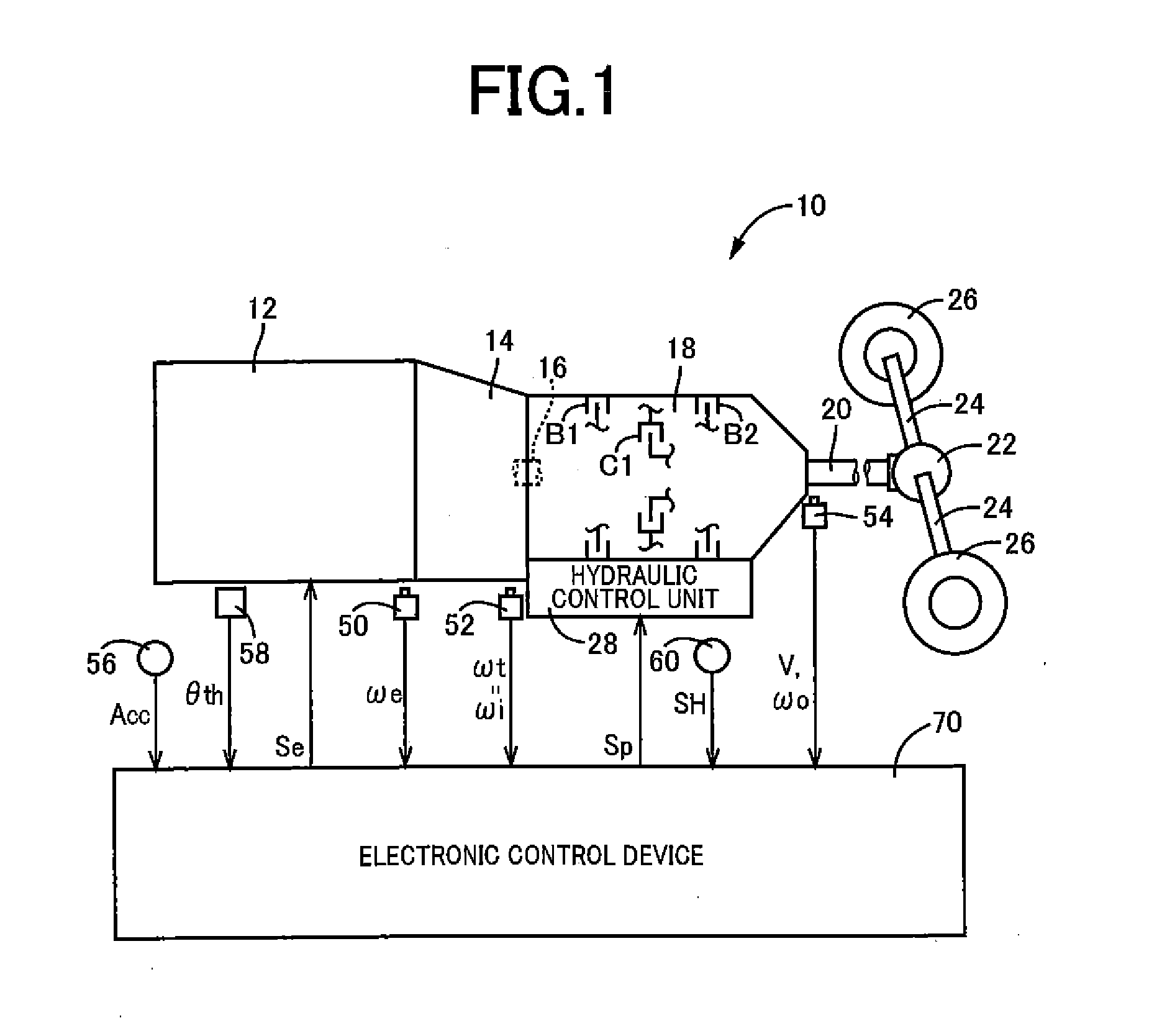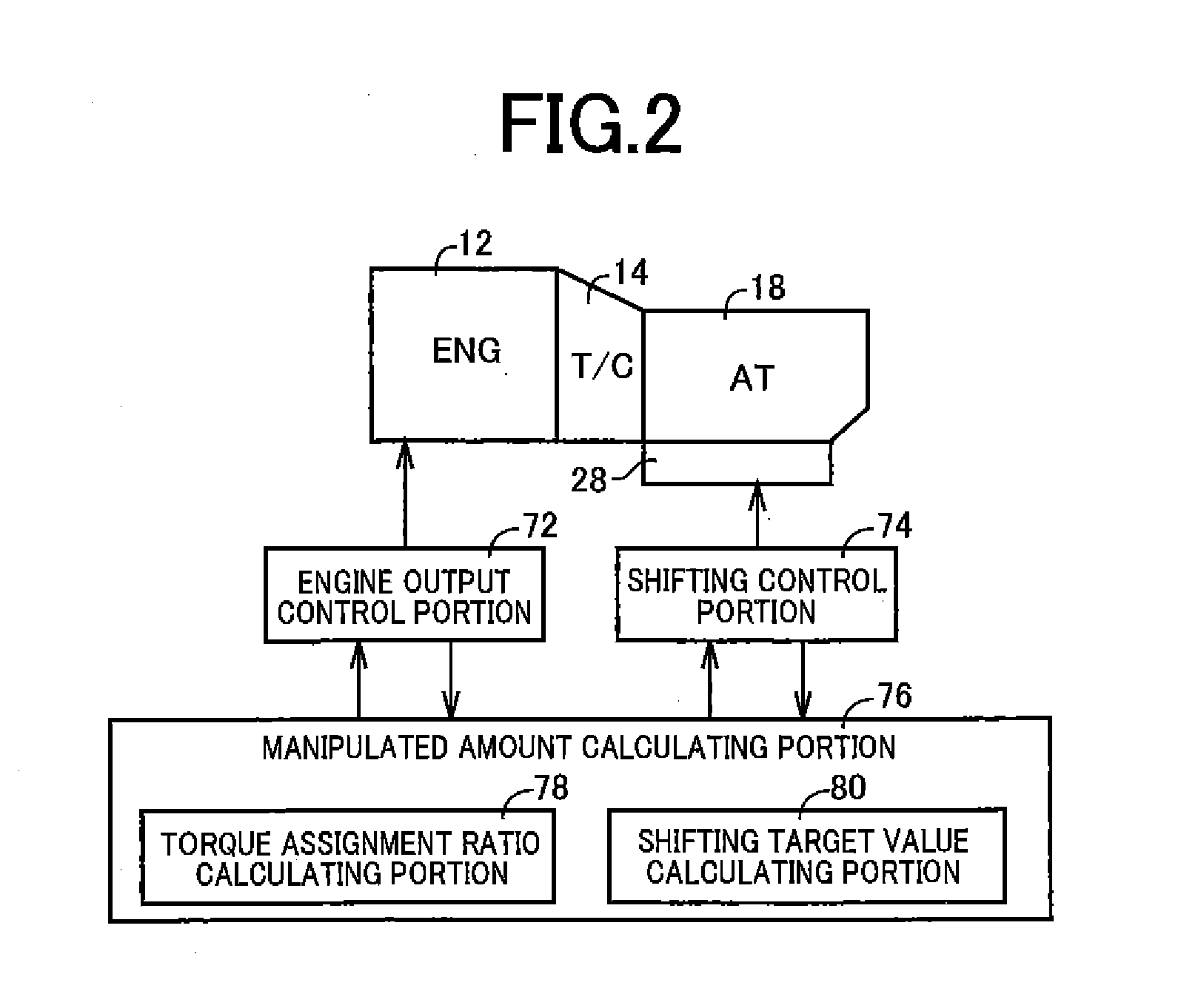Vehicle transmission controller
a technology of transmission controller and transmission shaft, which is applied in the direction of mechanical equipment, digital data processing details, instruments, etc., can solve the problems risk of deterioration of vehicle drivability, and motion equations that do not consider the engine as a controlled object, so as to reduce the risk of tie-up or racing phenomenon, reduce the output torque, and improve the effect of control
- Summary
- Abstract
- Description
- Claims
- Application Information
AI Technical Summary
Benefits of technology
Problems solved by technology
Method used
Image
Examples
first embodiment
[0024]FIG. 1 is the schematic view for explaining an arrangement of a power transmitting path from an engine 12 to drive wheels 26 of a vehicle 10 to which the present invention is applicable, and a major portion of a control system provided for the vehicle 10. As shown in FIG. 1, a drive force generated by the engine 12 serving as a drive power source is input to an automatic transmission 18 through a torque converter 14 and an input shaft 16, and is transmitted from an output shaft 20 of the automatic transmission 18 to the right and left drive wheels 26 through a differential gear device (differential gear) 22 and a pair of axles (drive shafts) 24 in this order of description.
[0025]The automatic transmission 18 is a known planetary gear type automatic transmission having one planetary gear set or a plurality of planetary gear sets, and a plurality of coupling devices (coupling elements), which are housed in a stationary member in the form of a transmission casing attached to a bo...
second embodiment
[0049]In the first embodiment described above, the target value of the transmission output torque To in the inertia phase is set as indicated in the time chart of FIG. 4, on the condition that the inertia torque can be entirely offset by the engine torque reduction control. Under some condition depending upon the specific shifting action, the specific two shift positions between which the shifting action takes place, the specific vehicle running speed V during the shifting action, the specific operating state of the engine 12, etc., however, there may be a case where only a part of the inertia torque can be offset. Under such condition, the shifting target value calculating portion 80 according to the present embodiment sets the target value of the transmission output torque To in the inertia phase, on the condition that only a part of the inertia torque can be offset by the engine torque reduction control. That is, the rest of the inertia torque which cannot be offset is added to t...
third embodiment
[0058]The second embodiment described above is configured to set the manipulated amounts so as to intentionally prevent the manipulated amounts from following the shifting target values, for reducing the shifting shock, in order to solve the problem of a risk of increase of the shifting shock due to a delayed change or variation of the actual values of the manipulated amounts controlled so as to follow the target value of the transmission output torque To. Namely, the second embodiment is not configured to set the shifting target values so as to reduce the shifting shock, for controlling the manipulated amounts so as to follow the thus set shifting target values. However, it is basically desirable to set the shifting target values so as to reduce the shifting shock, for controlling the manipulated amounts so as to follow the thus set shifting target values.
[0059]In the preceding second embodiment wherein the torque assignment ratios include the added tie-up amount α, the torque assi...
PUM
 Login to View More
Login to View More Abstract
Description
Claims
Application Information
 Login to View More
Login to View More - R&D
- Intellectual Property
- Life Sciences
- Materials
- Tech Scout
- Unparalleled Data Quality
- Higher Quality Content
- 60% Fewer Hallucinations
Browse by: Latest US Patents, China's latest patents, Technical Efficacy Thesaurus, Application Domain, Technology Topic, Popular Technical Reports.
© 2025 PatSnap. All rights reserved.Legal|Privacy policy|Modern Slavery Act Transparency Statement|Sitemap|About US| Contact US: help@patsnap.com



